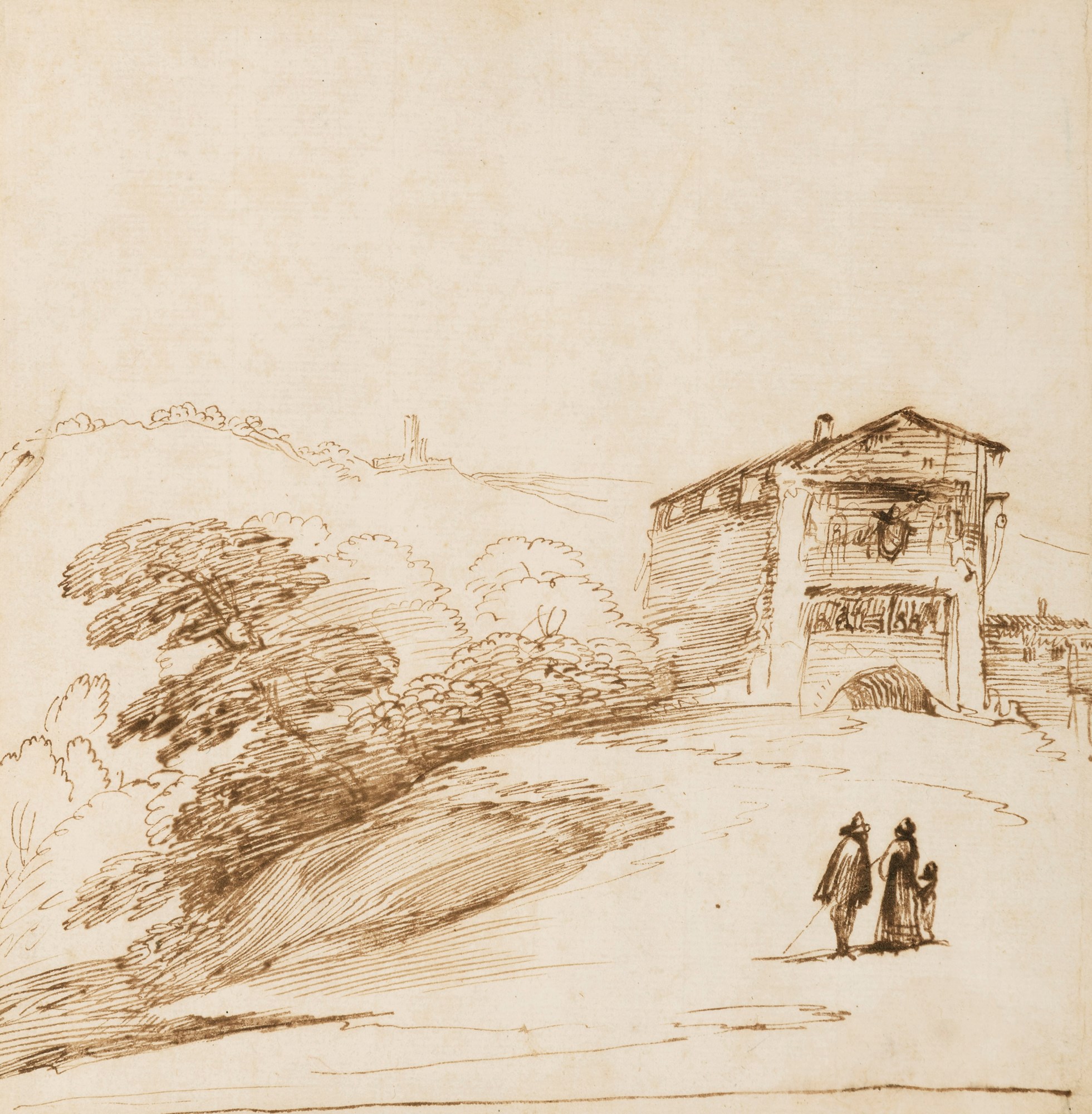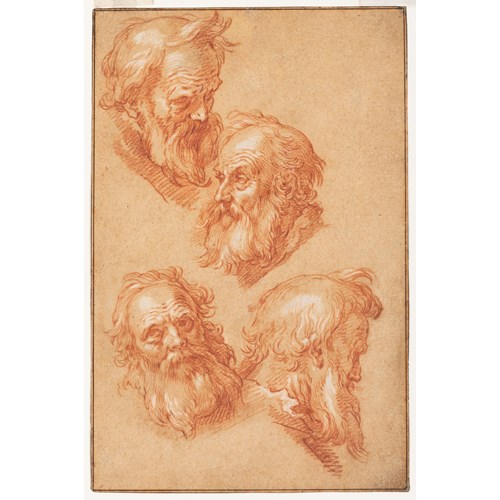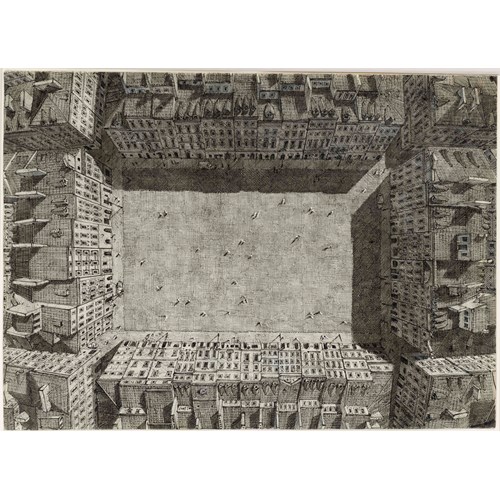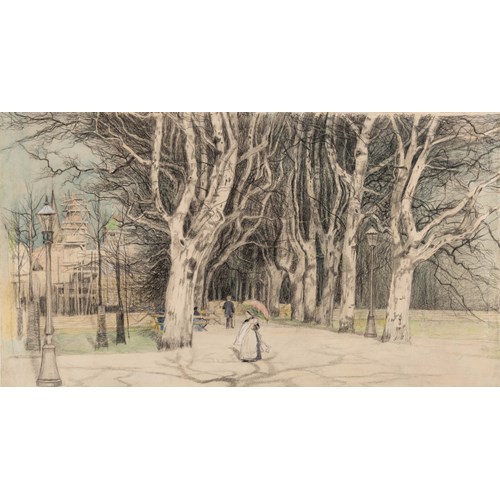Giovanni Francesco Barbieri GUERCINO
Landscape with Travellers Before a Rustic Building
Almost always executed in pen and ink, but only very rarely with wash, Guercino’s landscape drawings display little of the reworking and experimentation so typical of his figure studies. Carefully composed and incorporating such stock elements as solitary windblown trees, many of these drawings were probably not drawn on the spot, although they often contain motifs reminiscent of the landscape and river of the artist’s native town of Cento. Indeed, while a number of Guercino’s landscape drawings appear to depict actual views in and around Cento, most are imaginary views, combining different topographical and figural motifs in a fanciful manner to create a pleasing scene. As Mahon and Turner note, ‘As statements, many of [these landscape drawings] have a completeness not found in his more experimental and hastily drawn figure studies, and they contain something of the force and concentration of a painting rather than a drawing. In them the artist demonstrates the fecundity and power of his imagination by inventing a scene, shaping the space within it, giving the whole a unity by the suggestion of light and, finally, evoking a mood – all within the confines of a relatively small piece of paper.’
In many of Guercino’s landscape drawings, there is an echo of the pastoral views of 16th century Venetian artists such as Giorgione, Titian and Domenico Campagnola. (The last of these, like Guercino, drew a large number of landscapes as independent works of art.) The artist may also have found other sources of inspiration in the work of such contemporaries in Rome as Agostino Tassi, Annibale Carracci, Domenichino and Paul Bril, all of whom produced landscape drawings. It has been further suggested that Guercino may have been influenced by Netherlandish landscape prints of the early 17th century, of which he may have owned some examples; he is certainly known to have admired the etchings of Rembrandt.
The present sheet is a fine and characteristic example of Guercino’s landscape drawings. A sense of spatial recession is achieved by the artist’s use of the pen, with darker and thicker strokes of ink in such prominent foreground elements as the trees at the left becoming progressively lighter and more delicate as the eye moves through the landscape towards the far distance. As Sir Denis Mahon noted of the present sheet, when it was included in the important exhibition of Guercino drawings held in Bologna in 1991, on the four hundredth anniversary of the artist’s birth, ‘This drawing [is a] typical example of how Guercino worked, quickly sketching out new landscape ideas.’
As has been noted, ‘there are always interesting details to be noted in Guercino’s landscapes’, and in this drawing it may be observed that the prominent building, despite its rustic appearance, is decorated with a grand stemma, or coat of arms. The inclusion of figures in the foreground is also typical of Guercino; as Turner has written of his landscapes, ‘Another characteristic of these drawings is the endless stream of little figures dotted about, enlivening the scene and at the same time providing a sense of scale: wayfarers, country folk engaged in different occupations, children playing together and the occasional yapping dog.’
Comparable landscapes by Guercino executed in the same rapidly-drawn pen technique include a Landscape with a Central Tree and a Church Spire in the Distance in the Blanton Museum of Art at the University of Texas in Austin and a Landscape with a Church on a Hill in a private collection. A school copy of the present sheet, more horizontal in orientation, is among the extensive collection of drawings by Guercino and his studio acquired from the Casa Gennari for the Royal Collection, and today at Windsor Castle.
Guercino’s landscape drawings were greatly admired well into the 18th century. Indeed, as early as about 1674 a series of fourteen of his landscape drawings were sent by the artist’s nephews Benedetto and Cesare Gennari to Paris to be engraved by the printmaker Jean Pesne. These were published a few years later in Italy, accompanied by a frontispiece designed by Cesare Gennari, while the original drawings were acquired soon afterwards for the collection of the Dukes of Devonshire at Chatsworth. The largest extant group of landscape drawings by Guercino, numbering almost forty sheets, is today in the Royal Library at Windsor Castle.
This landscape is likely to have been part of the large group of drawings by Guercino that remained in his studio at the time of his death and were kept at the Casa Gennari in Bologna. According to the Bolognese biographer Carlo Cesare Malvasia, the Gennari collection included ‘Ten volumes of drawings, some in pen, some in red and black chalk, with a variety of exquisitely drawn landscapes’. In the inventory of the Casa Gennari, drawn up in October 1719, several albums of drawings by Guercino are listed, one of which contained ninety-two landscapes (‘Dissegni à Penna ed’ Acquarella rapresentanti vedute di Paesi diversi’), while another was partly made up of ‘Paesi piccolo di Penna, Acquerella, e Lapis’, amounting to some sixty-nine sheets. Of the two hundred landscape drawings by Guercino listed in the 1719 inventory, five were valued very highly, at twenty-five lire each. Furthermore, in another indication of how these works were particularly highly regarded, some thirty landscape drawings by Guercino were framed and displayed on the walls of the Casa Gennari in Bologna and the family’s country villa at Bel Poggio, outside the city.
Provenance: Probably by descent from the artist to his nephews, Benedetto and Cesare Gennari, the ‘Casa Gennari’, Bologna
Thence by descent to Carlo Gennari, Bologna, and probably sold in the second half of the 18th century
Anonymous sale, London, Sotheby’s, 28 June 1979, lot 155
Prisco Bagni, Bologna
Thence by descent
Anonymous sale, New York, Sotheby’s, 25 January 2017, lot 25
W. M. Brady and Co., New York
Private collection, New York.
Literature: Denis Mahon and Nicholas Turner, The Drawings of Guercino in the Collection of Her Majesty the Queen at Windsor Castle, Cambridge, 1989, p.169, under no.584; Sir Denis Mahon, Giovanni Francesco Barbieri il Guercino 1591-1666: Disegni, exhibition catalogue, Bologna, 1991 [pub. 1992], p.286, no.183; Massimo Pulini, ‘Guercino di fronte al paesaggio’, in Massimo Pulini, ed., Guercino: racconti di paese. Il paesaggio e la scena popolare nei luoghi e nell’epoca di Giovanni Francesco Barbieri, exhibition catalogue, Cento, 2001, p.61, p.64, fig.12 (as Cesare Gennari).
Exhibition: Bologna, Museo Civico Archeologico, Il Guercino: disegni, 1991, no.183; New York, W. M. Brady & Co., Old Master Drawings, Oil Sketches, and Sculpture 1520-1900, 2018, no.11.
More artworks from the Gallery









